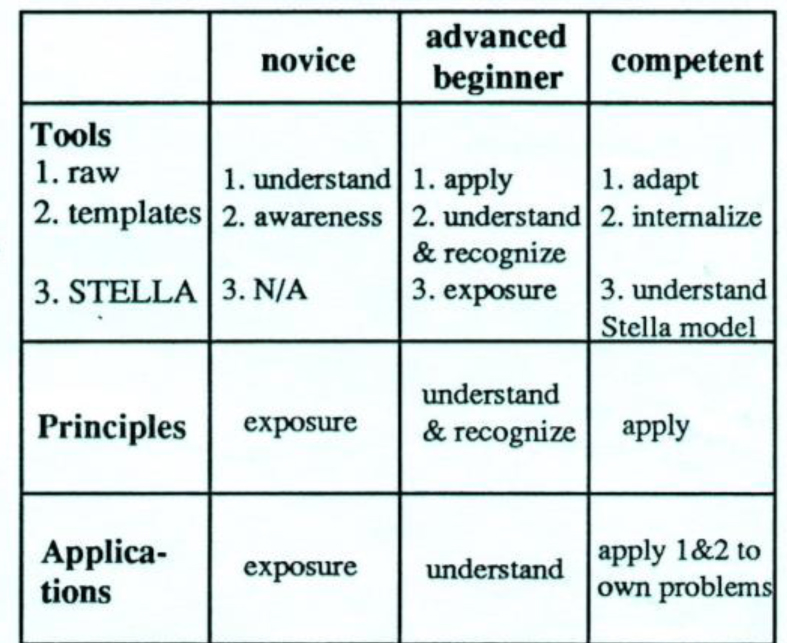The Systems Thinking Competency Course (STCC) project at the MIT Sloan School of Management is exploring how systems thinking can be translated into the workplace. The research, part of the Systems Thinking and Organizational Learning Research Program, has two main objectives: to design a course that will teach a variety of systems thinking skills and to evaluate its effectiveness for integrating systems thinking into corporate decision making. The STCC project represents a collaborative research effort between academia and corporations by bringing together both MIT researchers and corporate sponsors to define the project’s scope and content.
According to project manager Janet Gould, the research will address three basic questions:
- What does it mean to be competent in systems thinking?
- What skills must people acquire in order to become competent in systems thinking?
- What additional skills are necessary to become an active facilitator of systems thinking within an organization?
Much of the initial work in the project has been devoted to defining what should be included in a list of systems thinking competencies. The diagram at the right shows a proposed framework for addressing the issue. Deciding what specific skills fall under each matrix cell is a crucial aspect of the research and will re-main fluid for some time. Even the current definition of the axes is a tentative selection.
Although dialog about the course content continues, a few formats for delivery of the course have been suggested. One possibility is to conduct an intensive, five-day course which would immerse the participants in the principles of systems thinking. Such an experience, explains Tom Grimes of Hanover Insurance Company, a sponsoring company, might help participants retain the lessons from the course. “We have such a capacity to think linearly in our lives,” he explains, “that it’s going to take a major learning experience to turn it around.”

Another possible format would be to have three days of instruction followed by “refresher courses” held every few months. In between, participants would keep logs describing how systems thinking is affecting their work. The iterative process could continue for a year or more, notes Gould.
Regardless of its final format, an essential element of the course will be team learning. Groups of people from the same division of a company will be encouraged to go through the course together and to continue using the skills they have learned back in the workplace. Explains Gould, “We think the learning might last longer with this method, because the participants would be working with a group of people with whom they can continue talking about systems thinking, rather than being isolated.”
Initially, the content of the course will be modeled after two courses already available—the MIT Summer Session, a week-long introduction to systems thinking, and a five-day course designed by consultant David Kreutzer for his clients. Both courses teach participants simple feedback loops and how to build simple computer models of complex systems. A limitation of both course designs, however, is that the skills covered do not fully address all the cells of the research matrix.
Grimes hopes to address four main objectives with the course:
1) To raise awareness of the limits and some of the potential dangers of linear thinking.
2) To use systems thinking as a way of identifying the assumptions we make underlying our decisions.
3) To develop a common language for talking about systemic issues.
4) To critique and expand our view of reality without getting into issues of personality or emotionality.
A prototype course should be ready in a few months. At that point, the researchers will begin to implement it in four or five participating companies. But Gould emphasizes that the course design is only part of the research project. “We also need to know from a research standpoint whether this course is going to do anything for a company. Are people actually learning what we’re expecting?”
…an essential element of the course will be team learning.
In order to evaluate the course, participants will answer questionnaires that test how well they have assimilated key concepts. Not only will their answers help the researchers gauge the success of the course, but Gould notes that the participants will also be able to track their own progress.
Internal facilitators will also play a crucial role in implementing systems thinking in a company. “Essentially you need to build up internal expertise in systems thinking,” explains Dan Simpson, Director of Planning at The Clorox Company. “Without that internal expertise, it’s unlikely any new thinking mentality will infiltrate the organization very well.” Simpson adds that a separate, more intensive course may be necessary to train the facilitators who will continue the systems thinking learning process inside their companies. “These people will continually make the translation from what is an academic field of study into operational action inside an organization.”
Despite the questions on how well the course might implement systems thinking in companies, there is no doubt among the course planners that systems thinking is a valuable tool for organizations. As Simpson describes it, “Systems thinking helps practicing managers begin to think through the ‘ripple effects’ of their decisions. It’s often not clear when you make a decision as a practicing manager in one area that there are interactions with other areas, intended or not. Systems thinking offers a way to control—or at least consciously manage—the ripple effect, as opposed to just letting things happen.”
